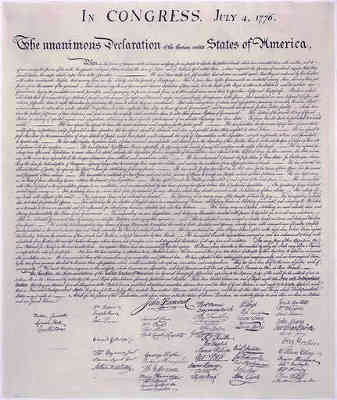The U.S. Constitution
A constitution is a set of rules which are set down for a government. The government then has to function according to those rules.
A basic form of American constitution was adopted in 1781 but this later proved inadequate. So in 1787, a new constitution was adopted by the American Congress.
Why was the Constitution needed?
Until 1775, American colonies were ruled by the British government. The British government approved most of the laws and rules which applied to the colonies. So the colonies never felt the need to create a constitution of their own.
But then in 1775, the American War of Independence broke out and in 1776, all the 13 American colonies declared independence from British rule. Now the colonies needed their own sets of laws, regulations and rules in order for the government to function properly. This was the reason why a constitution was needed.

Articles of Confederation
In 1777, the Second Continental Congress passed the Articles of Confederation. These were a basic set of rules which united all 13 states in the Union and described the powers of the central government.
It took 4 years for the Articles to be approved by all 13 states and they were adopted in 1781. By this time, war was nearly over and now the government had the actual task of managing all the 13 states.
Soon, everyone realised that the Articles of Confederation were not enough. A more detailed and proper constitution was needed for the newly-born United States of America. So in 1787, delegates from each state participated in the Constitutional Convention where they had to create a new constitution.
Constitutional Convention
The Constitutional Convention met in May 1787. Initially, the delegates simply planned to improve the Articles of Confederation so that they would become better suited for government. But soon everyone realised that they needed an entirely new constitution with more powers vested in the central government.
So discussion began for a new constitution and the delegates discussed different aspects of the constitution in detail. Finally, the Convention selected five men to actually write down the Constitution in light of the discussions of the delegates. These 5 men included John Rutledge, Edmund Randolph, Nathanial Gorham, Oliver Ellsworth and James Wilson.
Approval of the Constitution
Once the five-member committee had written down the constitution, the Constitutional Convention met once again in September 1787. This time, they simply discussed the draft written by the five selected men.
After some discussion and minor changes, the Constitution was finally accepted by all states. By March 1789, all the states had accepted and signed the document. So it became the constitution of the United States of America.
Changes in the Constitution
The U.S. Constitution changed over time. These changes simply reflected the new needs and duties of a government. The first major changes to the U.S. Constitution were made in 1791.
They were collectively called the ‘Bill of Rights’. These amendments included many important changes, such as the right to freedom of speech, protection from unlawful search, right to bear arms, the right to protest and a number of other rights. Since these amendments defined the rights of the citizens, it was termed the Bill of Rights.
- Birth of the USA
- 1st Amendment
- 2nd Amendment
- American Enlightenment
- American National Anthem
- Articles of Confederation 1777
- Betsy Ross
- Bill of Rights
- Birth of USA Timeline
- Christopher Columbus
- Declaration of Independence
- Federalism
- Is the United States a Democracy?
- Isolationism vs. Interventionism
- Liberty Bell
- Pledge of Allegiance
- The Torch of Liberty
- The U.S. Constitution
- Treaty of Paris
- War of Independence
- Washington D.C
- What Is The American Dream?